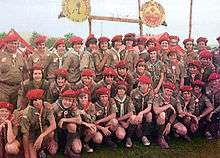Scout troop

The Scout troop is a collective term for a group of Scouts, Boy Scouts, Girl Guides and Girl Scouts that is composed of Scouts, typically children of both or either sex, ages 10 to 18 years depending on their national association. Girl Guides often use Unit or Company instead. The troop is often the fundamental unit of a Scout group, which a Scout joins and via which he or she participates in Scouting activities. The troop size can vary from as few as a half-dozen Scouts to several dozen.
Organization
The original intent of Baden-Powell, which is still implemented in most national Scouting associations, is that a Scout troop be divided into small groups of 6 to 8 Scouts called patrols.[1] A key component of the Scout method is that troops are run by the Scouts under the advice and guidance of adult leaders. The patrol method is the most common way that scout-run troops are run, especially in Boy Scouts.[2]
In many countries a local organization called a Scout Group combines a Scout troop with other groups of different age levels together in a single body. For example, a Beaver Scout Colony, a Cub Scout Pack, a Scout troop, a Venture Scout Crew and a Rover Scout Crew together might form a Scout Group. In other countries, the different sections are independent of each other, although they might be sponsored or chartered by the same community organisation, such as a business, service organisation, school, labor group veteran's group, or religious institution. The chartering organization is responsible for providing a meeting place and promoting a good program.
Activities
Scout troops typically meet weekly at a regular meeting place. In addition to these regular meetings, many Scout troops are active in the organization of additional Scouting and outdoor activities, such as hiking, camping or sailing. The activities of a Scout troop are generally organized by the Scout Leader.
Leadership
Baden-Powell intended that Scout Troops form a Court of Honour, a committee composed of the adult leader of the Scout Troop and the Scouts serving as leaders of their respective patrols.[1] The Court of Honour is directly responsible for management of the Scout troop, in particular matters regarding the activities, events and programme of the troop.[1] The leadership role of the adult and Scout members of the Court of Honour vary, and in many troops it is the norm for the adult leader to play a mentorship role, teaching the youth responsibility in their own leadership roles.